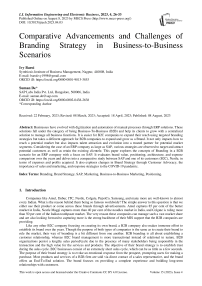Comparative Advancements and Challenges of Branding Strategy in Business-to-Business Scenarios
Автор: Ivy Baroi, Suman De.
Журнал: International Journal of Information Engineering and Electronic Business @ijieeb
Статья в выпуске: 4 vol.15, 2023 года.
Бесплатный доступ
Businesses have evolved with digitization and automation of manual processes through ERP solutions. These solutions fall under the category of being Business-To-Business (B2B) and help its clients to grow with a centralized solution to manage all business functions. It is easier for B2C companies to expand their reach using targeted branding strategies but takes a different approach for B2B companies to expand and grow as a Brand. It not only impacts how to reach a potential market but also impacts talent attraction and evolution into a trusted partner for potential market segments. Considering the case of an ERP company as large as SAP, various strategies are observed to target and attract potential customers as well as retain the existing clientele. This paper explores the concepts of Branding in a B2B scenario for an ERP company with a focus on SAP. It evaluates brand value, positioning, architecture, and expense comparison over the years and delves into a comparative study between SAP and one of its customers (B2C), Nestle, in terms of expenses and profits acquired. It also explores changes in Brand Strategy through Customer Advocacy, the importance of sales and marketing, and response strategies to the COVID-19 pandemic.
Branding, brand strategy, sap, marketing, business-to-business marketing, positioning
Короткий адрес: https://sciup.org/15018878
IDR: 15018878 | DOI: 10.5815/ijieeb.2023.04.03
Текст научной статьи Comparative Advancements and Challenges of Branding Strategy in Business-to-Business Scenarios
Published Online on August 8, 2023 by MECS Press
Companies like Amul, Dabur, ITC, Nestle, Colgate, PepsiCo, Samsung, and many more are well-known to almost every Indian. What is the reason behind them being so famous worldwide? The simple answer to this question is that we either use their product or come across these brands through advertisements. Amul captures 85 per cent of the butter market in India, Nestle Maggi captures more than 40 per cent of the noodles market in India, and Colgate is ruling more than 50 per cent of the Indian toothpaste market. The very reason these companies can manage such a vast market share and are also looking forward to capturing more is the strong backbone of their MIS support that the B2B companies are providing.
Like any other B2C company focusing on creating its own brand, a B2B company also makes immense effort to establish its brand over the years. Though the purpose of both types of companies is the same as to create their brand to rule the market, their way of branding is a bit different from one another. B2B branding is all about establishing a customer relationship, whereas B2C brand management is more transactional instead of relational in nature. B2B organizations persist a lengthy sales period/cycle due to the presence of many stakeholders being responsible in the transaction and the high value for the services and products. The objective of their brand strategy is to establish trust during the sales cycle. B2C businesses consist of an extremely short sales cycle, which can be as little as a few seconds. The purpose of their brand strategy is to evoke an emotional response from the prospect, prompting users for making a purchase. Most products and services of a B2B firm are sold via direct contact of a sales representative, and the brand offers an End-To-End solution. The brand focuses on providing a complete experience and building long-term relationships with customers.
The most renowned SaaS B2B companies are Microsoft, SAP, HubSpot, Oracle, Salesforce, and a lot more that rule the world with their software solutions. According to The Economic Times, SAP India has captured more than 10,000 companies in India, and among them, 80 per cent are SMEs. Nestle, Colgate, Amazon, Hindustan Unilever, Dabur, PepsiCo, GAIL, Samsung, TATA Steel, and numerous brands are supported by this brand, SAP.
2. Literature Survey
Branding aspects of any business depends on the Market Segment it caters to. In this section, we discuss on similar works around Brand building and relevant works that has impacted organizations in the recent times.
2.1. Branding in B2B Marketing
Brands are intangible assets that provide additional value to a company. This problem is around strategic brand management, and the central focus is how to produce value through effective brand management. In B2B marketing, branding is critical and has earned a huge amount of attention. Business sectors must distinguish themselves from their competitors not just in terms of product, but also in terms of managerial abilities, technology, services, and infrastructure. Industrial product marketers, both large and small, must develop efficient brand strategies to compete against global competition. The goal of this manuscript was to outline the branding process. They also look at challenges that B2B companies have when it comes to branding. Finally, the article finishes by providing corporate branding techniques in today's global economy. This article also discusses the importance of consistency and clarity in the development process of the brand strategy. [1] According to Kotler and Pfoertsch, a five-step branding process should be followed:
1) Planning
2) Analysis
3) Strategizing
4) Building
5) Auditing
2.2. Investigating the Effect of Global Brand on Willingness to Pay More by Mediation of Brand Perceived Quality, Brand Image, and Brand Prestige
2.3. B2B branding in New upcoming Markets with sustainability3. Exploring SAP as a Brand
3.1. Brand Value
3.2. Brand Architecture
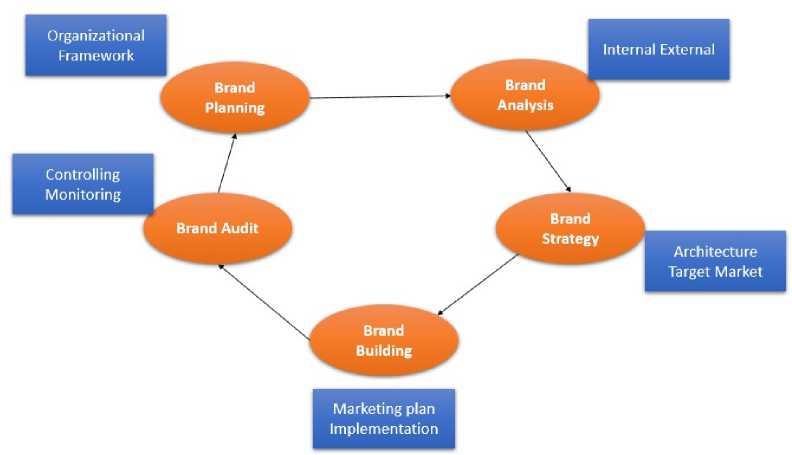
Fig. 1. 5-step Branding Process [1]
Due to the sheer globalization in the world economy, it is vital than before to have clarification on why certain customers favor global brands over local businesses. Furthermore, global branding allows businesses to create a better perception for their products and services, in addition to its many benefits. [2] This study looks at how customers' willingness to spend more is influenced by the perceived brand quality, image, and prestige. In order to achieve so, library research was conducted, with the findings revealing a direct and positive relationship between global brand and brand image. Furthermore, the mediation of brand perceived quality, brand image, and brand prestige is found to have an indirect effect on the rediness to pay more for a worldwide brand. At the end, the conceptual template is presented, which is based on research findings. [3]
B2B enterprises operate in socioeconomically and environmentally fragile locations, particularly in emerging markets. The intent of this research article is to provide a hypothetical model based on the possible use of sustainability for improving the company image while also reaping financial and social benefits. This paper focused on the mindset of companies shifting their strategy from bring market, consumer, or even shareholder driven. The report examines several case studies of chosen industrial enterprises in emerging economies that have implemented the triple bottom line methodology to illustrate this. The article suggests a research proposal for B2B brand creation on a sustainable platform in evolving markets based on the strategy presented. [4,5]
SAP caters to its customers with a foray of solutions that addresses business processes and helps organizations run better. This section explores different aspects of SAP as a brand and how it has evolved over time. It covers the topic of Brand Value, Architecture, Positioning, and Customer Loyalty.
Talking about SAP, it started with only one customer and few employees, and today it transforms the way companies do business. According to The BrandZ™ Top 10 Most Valuable German Brands 2021, SAP ranks 1st with a Brand Value of $55609 million. Brand value simply means the monetary worth of a brand if it is to be sold. Trust, transparency, and customer experience are the core to SAP’s success in creating a strong brand. SAP was one of the initial corporate software firms to provide solutions and assistance to over 25 industries for aiding with supply chain disruption, hybrid/remote work, and ensuring favorable customer satisfaction when the COVID 19 pandemic in 2020 first began to affect the businesses. SAP and its partners supplied tools and software solutions to support employees, customers, and company processes keep up and running in this fast-changing environment in response to the difficulties companies face. SAP has created the Spotlight Black Businesses initiative as part of the commitment SAP made for combating injustice and fostering racial equality. This campaign aims to provide social media and advertising help to s mall, Black-owned companies that have been affected by the shutdown due to the pandemic. SAP has made solid progress on its internal dimensions of brand leadership in 2020.
It refers to the organized structure of a company’s portfolio and its relationship. An effective Brand Design enables its users to form preferences and views for the complete range of brands after knowing just one of them. The brand identity is created through the SAP corporate logo that can only be used in the configurations mentioned by the company and the tag line “Run Simple”. Based on the principle of everlasting movement and invention, the organization created a visual style. It built a proprietary color, font, photography, iconography, illustration, animation, and data visualization language including over 300 elements that touched every aspect in the firm. SAP was able to tell a compelling story about its products in a unique manner toward a diverse group of people. The better visual brand supported a smooth customer satisfaction, whether it was a digital experience, media events, or talent acquisition. The brand identity explains SAP’s increasingly customer-centric perspective and cutting-edge solutions, which they have been winning for years. The brand architecture places SAP as the master brand with the sub-brands placed below it like, SAP S/4 HANA (10), SAP Business One, SAP ERP, SAP CRM, SAP SCM, and many more.
3.3. Brand Positioning
SAP began as an ERP software company and had since grown to become a major participant in the ERP industry. SAP developed strong partnerships with several alliance partners to assist themselves and be given weaponry and ammo in order to grow ERP. And today, there are a plethora of third-party developers that provide a variety of add-on applications that integrate with SAP products. SAP also provides ERP systems that are suitable for businesses of all sizes and geographical requirements.
3.4. Customer Loyalty
To understand the non-financial performances in the area of Consumer Loyalty, in the year 2020, SAP conducted a survey. The yearly evaluation of user loyalty is depended on the survey that included Net Promoter Score (NPS) matrix. The NPS is utilized to anticipate economic growth. When a company's NPS is high (or at least over the industry average), it indicates that it has a loyal customer base, that are has a higher likelihood to act as advocates and result in a beneficial growing period. The Customer NPS score is generated using proprietary scoring and the NPS Likelihood to Recommend question, which is rated on a scale of 0–10. SAP implemented this measure in 2012 because they believe that their financial goals can only be met if their customers are loyal and pleased with SAP and its solutions. They start by estimating the proportion of SAP "promoters," or those who give us a rating of 9 or 10 on a range of 0-10. The percentage of "detractors," or those who give us a score between 0 and 6, is then deducted. The method ignores "passives," or those with a score of 7 or 8. As a result, based on the Customer NPS approach, the range of potential values is -100 to +100, with +100 being the largest achievable rating for customer satisfaction.
In early 2020, SAP combined customer-facing staff into a single organization named Client Growth. This transformation enabled SAP's customer-facing groups to collaborate greater frequently, providing the framework for the corporation to provide the value and experience that customers require. They've also introduced a new operational model that unites sales, services, and customer engagement operations to provide a uniform experience for customers across interactions. Over the following three years, they will apply this organizational structure with the purpose of improving client engagement and consumption of their offerings, as well as their commercial outcomes.
SAP recently implemented a variety of global initiatives to ensure that its clients remain their top focus. Changes in how businesses communicate with and care for their consumers, as well as actions to maintain a uniform, end-to-end journey, are all part of this. SAP makes modifications based on feedback from customer surveys done with Qualtrics technology. They've also announced a slew of new tools to aid clients along the way, including SAP Road Map Explorer, an interactive tool that showcases SAP's future product lineup. SAP for Me is a digital platform that provides as a single source of information for SAP engagements. [6,7] Their Observations to Operational plan continue to conduct in-depth analyses of customer experience to understand how they may improve account management as well as their goods and services. This programme has been enhanced by establishing an engagement process that spans geographies, solutions, and services, allowing them to take a more comprehensive perspective to how they manage the organization, create strategies, and serve their clients. They are capable of monitoring, managing, and improving the value and experience of their clients from different areas and sectors. SAP wants to be a firm that listens and answers to its consumers by focusing on empathy. Customers should be able to use an SAP that is always developing. The company wants to boost customer loyalty by using this strategy and measure by the client NPS [8,9].
-
4. Comparison between SAP (B2B) and Nestle (B2C)
SAP caters Nestlé, which has been headquartered in Switzerland since 1866, is a multinational corporation with six business areas, over 2,000 brands, and 308,000 workers. Nestlé's aim was to become its nation’s largest health, nutrition, as well as wellness organization. It also wanted to expand its reach of customers and desired to spread across the world. But without a proper ERP system this dream of Nestle seemed impossible. This is where SAP enters Nestle. Nestle being a B2C company could not achieve its desired goal on its own, it needed the support of a B2B company to maintain the smooth running of all the company functions.
Table 1. Comparison for Sales and Marketing Expenses and Net Profit for SAP and Nestle (in Crores) (Source: Financial Statements)
|
Year |
Sales & Marketing Expenses (INR) |
Net Profit (INR) |
||
|
SAP |
Nestle |
SAP |
Nestle |
|
|
2015 |
49,438 |
1,68,857 |
26,204 |
74,035 |
|
2016 |
53,568 |
1,74,796 |
31,181 |
69,153 |
|
2017 |
59,203 |
1,61,234 |
34,277 |
58,577 |
|
2018 |
57,980 |
1,62,739 |
34,918 |
82,170 |
|
2019 |
65,778 |
1,61,006 |
28,402 |
1,02,510 |
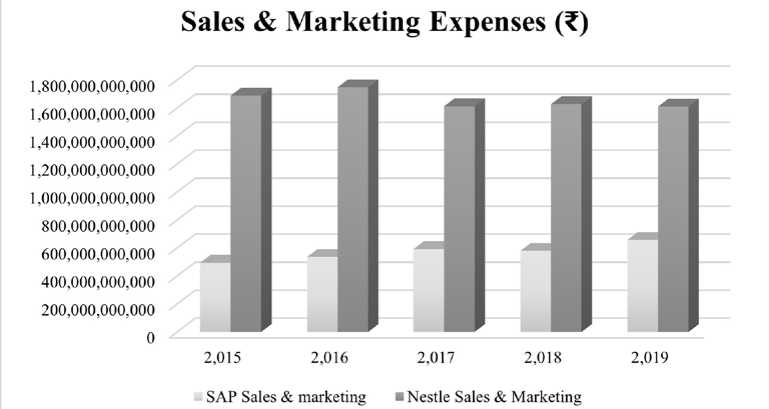
Fig. 2. Expenses comparison between SAP and Nestle Sales and Marketing (Source: ‘The Author’)
The above graph depicts the sales and marketing expenses of both the companies from the year 2015 to 2019—the blue block representing SAP and the grey one representing Nestle. Here we can see that the sales and marketing expenses of SAP are comparatively very less than Nestle. It can be assumed that the Sales and Marketing expenses of
SAP are 1/3 of the Sales and Marketing expenses of Nestle.
One of the major components required for brand awareness or branding is the marketing of that brand, and the sales of the products offered by the brand and Sales and Marketing requires a major amount of expenses. But from the above comparison between SAP and Nestle, it is very clear that a B2B company requires comparatively less expenses than a B2C company.
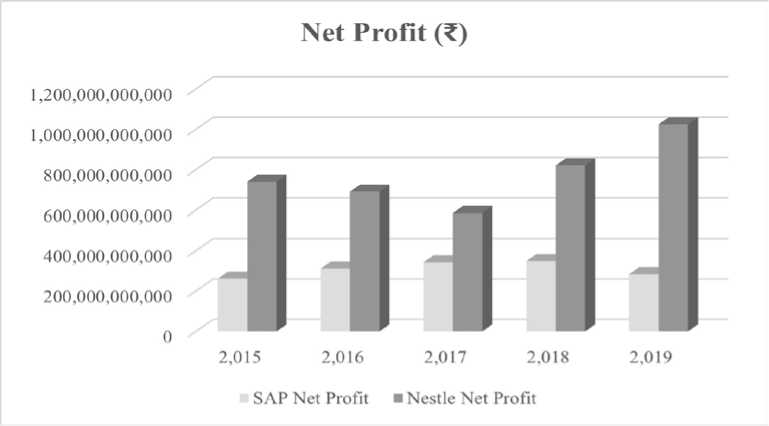
Fig. 3. Net Profit comparison between SAP and Nestle Sales and Marketing (Source: ‘The Author’)
Net profit is the amount of money a corporation produces after deducting all operating, interest, and tax expenses over a specified timeframe. The above statistics represent the Net profit of both the companies from the year 2015 to 2019. The blue column being SAP and the grey column being Nestle. The clarity for the above graph that the giant FMCG has a good amount of Net Profit compared to the B2B giant SAP. This graph proves that along with all the other components of Nestle that helps it gain its profits, this B2B giant SAP adds to its success.
-
5. Sales and Marketing
Comparison between the Sales and Marketing expenses of a B2B company and a B2C company. B2B product firms spend nearly two-thirds of their marketing expenditures on direct marketing expenses, whereas B2C product organizations consumed just 57 percent which might be due to B2C businesses classify marketing spending widely and include those in sales or operations budgets.
В2В Product
Direct expenses of marketing Social media
Marketing employees Marketing research
Marketing training
Marketing analytics Other overhead
B2B Services

Direct expenses of marketing
Social media ^^^^^^^^^^^■^^^^^^^^^^^■l 49%
Marketing employees ^^^^^^^^^^^^^^^^^^^^^^^^^H 51%
Marketing research ^^^^^^^^^^^^^^^^^^H 37%
Marketing training ^^^^^^^^^^e 26%
Marketing analytics ^^^^^^^^^^^^^^^^^^e 42%
Other overhead ^^^^^^^^^^^^^^^^^H <8%
Fig. 4. Expenses for B2B products and Services (Source: The Wall Street Journal)
В2С Products
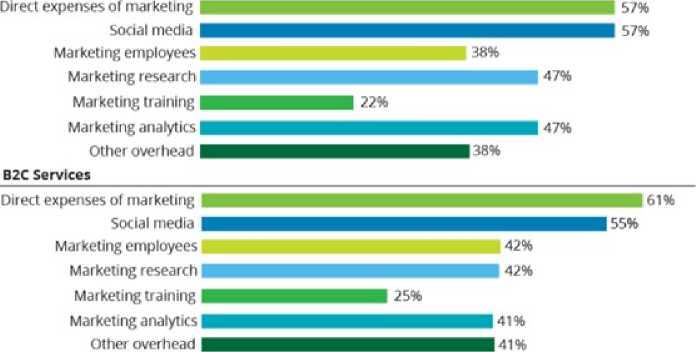
Fig. 5. Expenses for B2C products and Services
Social media expenditures are included in the marketing budgets of slightly more than half of organizations (51.4%). This proportion is higher for B2C product firms (57%) than for B2B product firms (50%) because B2B product firms spend less on social media or invest social media costs in technology or corporate communications. Less than half of marketers' marketing budgets contain marketing analytics (8), marketing research, marketing training, and other overhead expenses.
Examining at SAP's Sales and Marketing costs, one can see that most of their sales and marketing expenses are made up of human costs, direct sales charges, as well as the cost of advertising their goods and services. Figure 6 indicates that sales and marketing expenditures decreased by 8% in 2020, from €7,693 million in 2019 to €7,106 million in 2020. The key causes of this decrease include the termination of in-person marketing events such as SAPPHIRE NOW, and lower sales-related spending. Consequently, the sales and marketing cost to total revenue ratio will fall by 1.9 percentage growth to 26.0 percent in 2020. (279.9% in 2019).
In 2019, sales and marketing expenditures climbed by 13%, from €6,781 million to €7,693 million. This surge is primarily attributable to the globalization of the sales force, which is due in part to the purchase of Qualtrics, in addition to higher expenditure on incentive payments as a result of considerable revenue growth. As just a consequence, the percentage of sales and marketing spend to total revenue climbed by a factor of 0.5 in 2019 to 27.9 percent (2018: 27.4 per cent). [10]
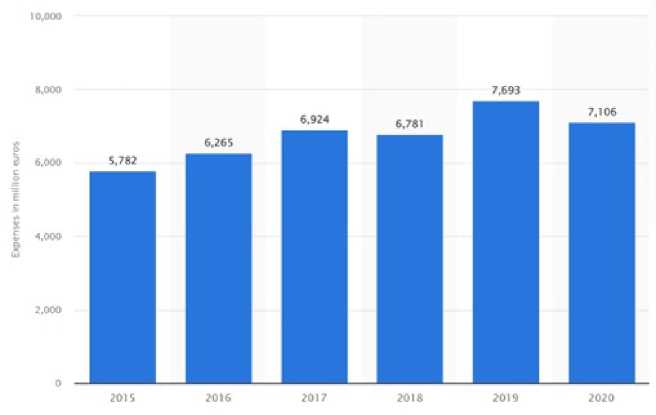
Fig. 6. Sales and Marketing Costs between 2015-2020 [11]
-
6. Customer Advocacy in Brand Strategy
A different and unique branding strategy was adopted by SAP in the year 2017. This started when Alicia Tillman became the new CMO of this tech giant in 2017. Alicia Tillman had a very different vision for the company's brand strategy. According to her, brands were proceeding towards humanization through the way they communicate regarding
building a relationship between their communities [12,13]. Resulting to which in the year 2019, marketers took the concept of years of loyalty and advocacy as their branding tool. The concept was to deliver a consistent and relatable narrative about the relationship built and maintained between SAP and its customers over the years, which includes the answer to the questions like who are the customers and prospects, what do they want, what do they need? And how do they feel? The brand must embrace its humanity and present a narrative in such a manner that people can feel and believe it. Authenticity and responsibility are required to leave a lasting impression and establish the network of advocates required for long-term success in the digital age. Customers' and employees' hearts are won over by brands that inspire strong connections on a personal level. [14]
-
7. Strategic Response during COVID-19
-
8. Conclusion
SAP has been assisting clients in adapting their companies and preparing for the new and unexpected challenges that the COVID-19 pandemic presents. Their objective was to provide solutions to help firms mitigate risks, ensure business continuity, and meet the needs of a rapidly changing business and health environment. Each of the changes were made with the purpose of having a positive impact beyond 2020.
SAP developed the Warn-App in collaboration with Deutsche Telekom and other partners. This same application was created to track COVID-19 infections in Germany and to disrupt transmission pathways. Since its launch by the German government in mid-2020, the app has been downloaded over 25 million times. The app is often linked to COVID-19 interaction tracking applications in Croatia, Denmark, Italy, Latvia, Spain, Poland, and the Republic of Ireland via the European Union (EU) compatibility portal, which was launched as an international and bridge project in October 2020. [15]
This same COVID-19 eruption served as a catalyst for change. Customers desired a faster transition to the cloud for increased dependability and agility, and SAP responded by providing the technologies and experience to assist them in transferring their existing IT systems to the cloud and radically changing their companies. The pandemic's first visible impact on SAP's business performance was in the third quarter, overshadowing an effective performance in the first and second quarters. Despite that COVID-19 situation remained unchanged and lockdowns have been reinstated in many regions, SAP's cloud business performed better sequentially in the fourth quarter, with continued high demand for e-commerce, SAP Business Technology Platform, and Qualtrics solutions resulting in a solid finish for SAP's cloud business for the year. SAP's new comprehensive business transformation product RISE with SAP also received positive early feedback from pilot clients, contributing to the fourth-quarter cloud performance.
SAP continues to support its customers with an incorporated virtual sales and remote installation approach during the COVID-19 pandemic. While accumulating logical discounts such as fewer travel, facility-related expenses, and virtual rather than physical events, the corporation maintained a tight recruitment and additional spending policy. Despite the difficult economic climate, these approaches led to increased operational profit (IFRS and non-IFRS at constant currencies) and operating income, in addition to good leading achievements.
Branding defines the way a company promotes and publicizes itself and its products to the market with a focus on a specific segment. It is something that defines people’s perception towards an organization, regardless of the same being B2C or B2B. Even in the case of an ERP company as large as SAP, this is a vital aspect, and various strategies are laid forward to target and attract potential customers as well as retain the existing clientele. This paper explores various concepts of B2B branding with a case study on SAP and how it has progressed over time with different strategies over the years. It also explored a comparative study on expenses on Marketing and Sales and profit of a customer, Nestle, highlighting the impact SAP has on its customers. The following sections explored various nuances on Sales and Marketing, Customer Advocacy, and strategies taken by SAP during the COVID-19 pandemic.
Acknowledgment
This comparative paper is possible due to the guidance of our organizations of SIBM Nagpur, SAP Labs India, and IIT Kharagpur and the authors have used this opportunity for extending their gratitude for providing the required support to work on topics related to this study.
Список литературы Comparative Advancements and Challenges of Branding Strategy in Business-to-Business Scenarios
- Akbari, & Hakimpour (2018). Branding in B2B Marketing. International Journal of Industrial Marketing, Volume 3, No. 1, 2018. DOI: https://doi.org/10.5296/ijim.v3i1.13321.
- Baroi and De. An Analytical Study on Consumer Perception for a Product against its Social Media Imprint. 2021 IEEE Intl Conference on Computation System and Information Technology for Sustainable Solutions (CSITSS). 2021. p. 1-6, doi: 10.1109/CSITSS54238.2021.9682783.
- Rahimnia and Sarvari, "Investigating the Effect of Global Brand on Willingness to Pay More by Mediation of Brand Perceived Quality, Brand Image, and Brand Prestige," 2019 15th Iran International Industrial Engineering Conference (IIIEC), 2019, pp. 70-75, doi: 10.1109/IIIEC.2019.8720626.
- Sheth & Sinha. (2015). B2B branding in emerging markets: A sustainability perspective. Industrial Marketing Management. Elsevier Inc. July 2015. DOI: https://doi.org/10.1016/j.indmarman.2015.06.002.
- De & Baroi. Importance of Analytics in Data-Driven Decision Making with Industry Case Study. New Horizons in Commerce & Management. High Rise Boks. Volume 9. P. 32-40. 2022
- Talbot. (2020, January 25). How SAP Cultivates Its Global Brand. p. 1. Available from https://www.forbes.com/sites/paultalbot/2020/01/25/how-sap-cultivates-its-global-brand/?sh=6590dba8558d.
- Economic Times. SAP launches Hana sees Indian cloud market at $4.1 billion by 2020. Tech, p. 1. 2018, May 10. Available from https://economictimes.indiatimes.com/tech/internet/sap-launches-hana-sees-indian-cloud-market-at-4-1-billion-by-2020/articleshow/64097974.cms?from=mdr.
- S. De and I. Baroi, "Evolution of Analytics in Product Management for Data-driven Feature Prioritization," 2022 Seventh International Conference on Parallel, Distributed and Grid Computing (PDGC), Solan, Himachal Pradesh, India, 2022, pp. 588-593, doi: 10.1109/PDGC56933.2022.10053237.
- M. Y. -P. Peng and Y. Li, "The Impact of Expressive Brand Relationship on Brand Loyalty: Drawing on relationship marketing theory," 2019 16th International Conference on Service Systems and Service Management (ICSSSM), Shenzhen, China, 2019, pp. 1-5, doi: 10.1109/ICSSSM.2019.8887611.
- Deloitte. (2017). Marketing Budgets Vary by Industry. The Wall Street Journal. Available from https://deloitte.wsj.com/articles/who-has-the-biggest-marketing-budgets-1485234137.
- Vailshery. (2022). SAP's marketing and sales expenses from 2015 to 2021. Statista. Available from https://www.statista.com/statistics/862003/saps-marketing-and-sales-expenses/.
- Y. Liu, "Enterprise Brand Marketing Strategy under the Background of Artificial Intelligence," 2021 International Conference on Forthcoming Networks and Sustainability in AIoT Era (FoNeS-AIoT), Nicosia, Turkey, 2021, pp. 115-119, doi: 10.1109/FoNeS-AIoT54873.2021.00033.
- Baroi, I., De, S. (2023). Using Marketing Cloud Applications for Better Analysis of Consumer Insights. In: Kumar, A., Ghinea, G., Merugu, S., Hashimoto, T. (eds) Proceedings of the International Conference on Cognitive and Intelligent Computing. Cognitive Science and Technology. Springer, Singapore. https://doi.org/10.1007/978-981-19-2358-6_46.
- How Tech Giant SAP Built Its Brand with Help from Employee Stories. 2019, March 6. Marketing, p. 1. Available from https://insight.kellogg.northwestern.edu/article/how-tech-giant-sap-built-its-brand-with-help-from-employee-stories.
- Kantar. (2021, March 11). SAP holds top position as Germany’s most valuable brand for the fourth year running. Get more Inspiration, p. 1. Available from https://www.kantar.com/inspiration/brands/sap-holds-top-position-as-germanys-most-valuable-brand-for-the-fourth-year-running.

